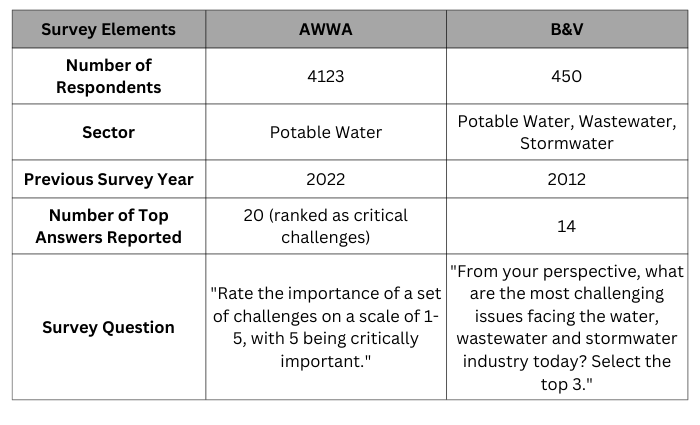By Felon Wilson

By coincidence, two independent surveys were recently released which identified key issues in the U.S. water industry. The reports are listed in Table 1.

While both reports address respondents’ perceptions of current and anticipated market conditions, there are differences in methodology as shown in Table 2.

Even with some differences in methodology, there were some very similar areas of concern. The following table highlights the top 10 areas of concern in the AWWA survey and the corresponding position of that same area of concern as it was ranked by correspondents in the B&V survey.
All of the top 10 in the B&V survey are also covered with the corresponding AWWA ranking, which in some cases is outside the top 10. For simplicity in this post, the summary below places some rankings in similar categories where they are considered within the same area (see Table 3).

Conclusions
Both surveys agree the number one concern is ageing infrastructure
Similarly, capital improvements and other cost-related issues are important, partially reflective of the overarching concern with ageing infrastructure.
The availability and quality of raw water is a concern that shows up in a number of ways in both surveys.
Workforce concerns are more pronounced with the broader water industry as opposed to the potable water industry. Perhaps this is reflective of the differences in perspectives of the “clean” vs. the “dirty” side of the industry.
Expanding regulations, particularly regarding toxins (PFAS) is a concern, showing up as number 4 in the B&V survey. It may be assumed perhaps that expanding regulations in the AWWA survey are also a component of the concern for capital improvements financing.
These surveys are concentrated on needs, concerns, and problems, but AWWA reports that optimism within the U.S. water industry is at an all-time high and continues to increase year over year. No doubt gains in technology such as those offered by geomembranes are a component of efficiency and cost savings which help drive increases in the effectiveness of water treatment and management processes. Specifically, high strength, thermally stable geomembranes are used extensively in potable water, wastewater, and stormwater applications in a number of ways:
NSF 61 liners for sunlight exposed raw water storage impoundments (More Information)
Exposed, thermally stable geomembranes to contain wastewater aiding in treatment processes and preventing sanitary sewer overflows, in lieu of hard-shell tankage (More Information
NSF 61 geomembranes to line and cover finished water reservoirs (More Information)
NSF 61 clearwell diversion curtains to aid in disinfection efficiency. (More Information)
The XR-5 reinforced ethylene copolymer geomembrane has a proven history in all of these applications. For further information, visit www.xrtechnology.com. Learn more about XR Geomembranes here.
To read the entire water surveys, go to: AWWA Survey and B&V Survey
 TEXTILES.ORG
TEXTILES.ORG


